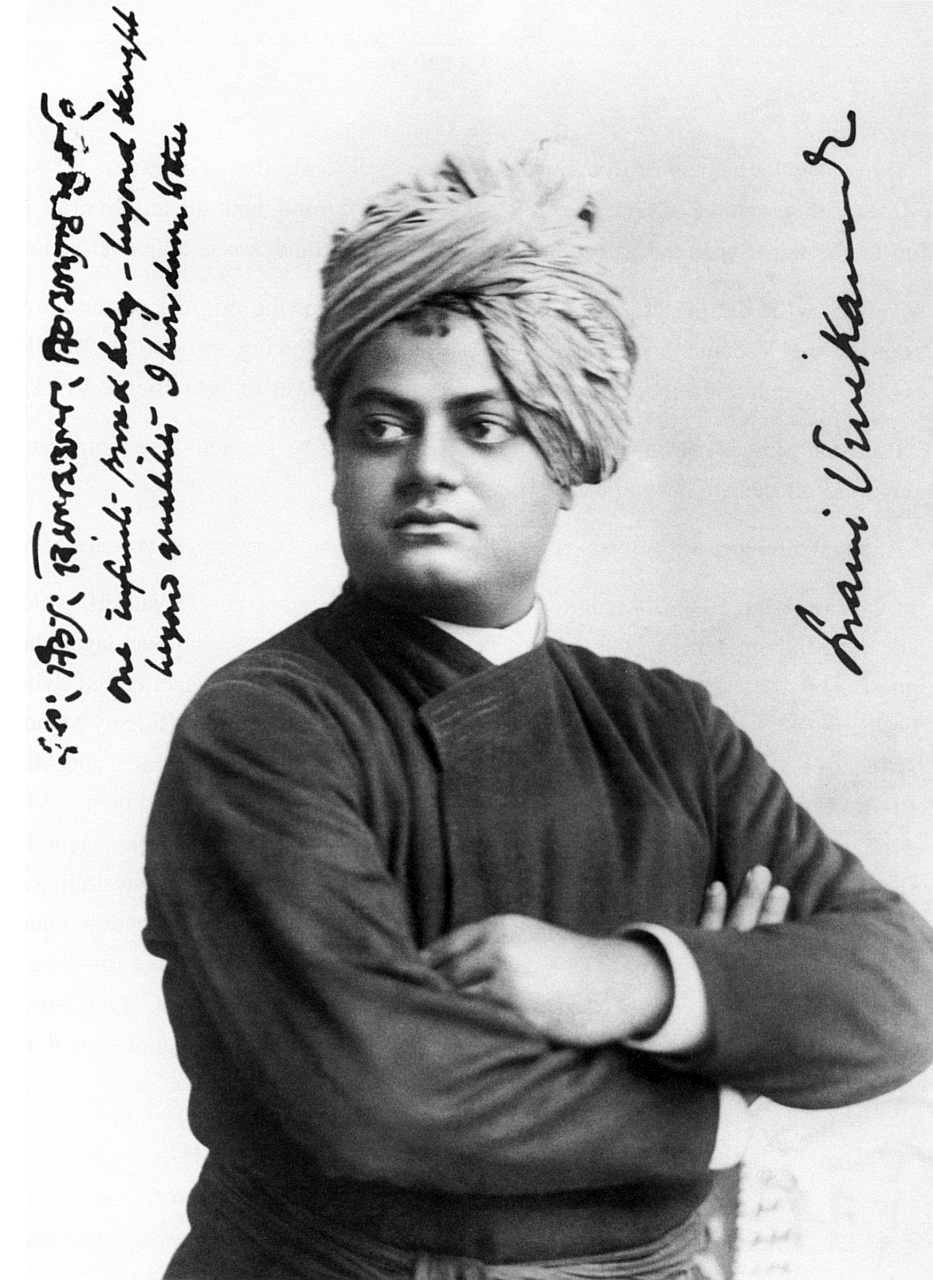
Swami Vivekananda
Swami Vivekananda (/ˈswɑːmi ˌvɪveɪˈkɑːnəndə/; Bengali: [ʃami bibekanɔndo] ⓘ; IAST: Svāmī Vivekānanda ; 12 January 1863 – 4 July 1902), born Narendranath Datta (Bengali: [nɔrendronatʰ dɔto]), was an Indian Hindu monk, philosopher, author, religious teacher, and the chief disciple of the Indian mystic Ramakrishna.[4][5] He was a key figure in the introduction of Vedanta and Yoga to the Western world,[6][7][8] and the father of modern Indian nationalism who is credited with raising interfaith awareness and bringing Hinduism to the status of a major world religion.[9]
"Vivekananda" redirects here. For other uses, see Swami Vivekananda (disambiguation).
Vivekananda
12 January 1863
4 July 1902 (aged 39)
Born into an aristocratic Bengali Kayastha family in Calcutta, Vivekananda was inclined from a young age towards religion and spirituality. He later found his guru Ramakrishna and became a monk. After the death of Ramakrishna, Vivekananda extensively toured the Indian subcontinent acquiring first-hand knowledge of the living conditions of Indian people in then British India. Moved by their plight, he resolved to help his countrymen and found a way to travel to the United States, where he became a popular figure after the 1893 Parliament of Religions in Chicago at which he delivered his famous speech beginning with the words: "Sisters and brothers of America ..." while introducing Hinduism to Americans.[10][11] He was so impactful at the Parliament that an American newspaper described him as "an orator by divine right and undoubtedly the greatest figure at the Parliament".[12]
After great success at the Parliament, in the subsequent years, Vivekananda delivered hundreds of lectures across the United States, England and Europe, disseminating the core tenets of Hindu philosophy, and founded the Vedanta Society of New York and the Vedanta Society of San Francisco (now Vedanta Society of Northern California),[13] both of which became the foundations for Vedanta Societies in the West. In India, Vivekananda founded the Ramakrishna Math, which provides spiritual training for monastics and householder devotees, and the Ramakrishna Mission, which provides charity, social work and education.[7]
Vivekananda was one of the most influential philosophers and social reformers in his contemporary India, and the most successful missionaries of Vedanta to the Western world. He was also a major force in contemporary Hindu reform movements and contributed to the concept of nationalism in colonial India.[14] He is now widely regarded as one of the most influential people of modern India and a patriotic saint. His birthday in India is celebrated as National Youth Day.[15][16]
Back in India (1897–1899)
The ship from Europe arrived in Colombo, British Ceylon (now Sri Lanka) on 15 January 1897,[149] and Vivekananda received a warm welcome. In Colombo, he gave his first public speech in the East. From there on, his journey to Calcutta was triumphant. Vivekananda travelled from Colombo to Pamban, Rameswaram, Ramnad, Madurai, Kumbakonam and Madras, delivering lectures. Common people and rajas gave him an enthusiastic reception. During his train travels, people often sat on the rails to force the train to stop, so they could hear him.[149] From Madras (now Chennai), he continued his journey to Calcutta and Almora. While in the West, Vivekananda spoke about India's great spiritual heritage; in India, he repeatedly addressed social issues: uplifting the people, eliminating the caste system, promoting science and industrialisation, addressing widespread poverty and ending colonial rule. These lectures, published as Lectures from Colombo to Almora, demonstrate his nationalistic fervour and spiritual ideology.[151]
On 1 May 1897 in Calcutta, Vivekananda founded the Ramakrishna Mission for social service. Its ideals are based on Karma Yoga,[152][153] and its governing body consists of the trustees of the Ramakrishna Math (which conducts religious work).[154] Both Ramakrishna Math and Ramakrishna Mission have their headquarters at Belur Math.[118][155] Vivekananda founded two other monasteries: one in Mayavati in the Himalayas (near Almora), the Advaita Ashrama and another in Madras (now Chennai). Two journals were founded: Prabuddha Bharata in English and Udbhodan in Bengali.[156] That year, famine-relief work was begun by Swami Akhandananda in the Murshidabad district.[118][154]
Vivekananda earlier inspired Jamsetji Tata to set up a research and educational institution when they travelled together from Yokohama to Chicago on Vivekananda's first visit to the West in 1893. Tata now asked him to head his Research Institute of Science; Vivekananda declined the offer, citing a conflict with his "spiritual interests".[157][158][159] He visited Punjab, attempting to mediate an ideological conflict between Arya Samaj (a reformist Hindu movement) and sanatan (orthodox Hindus).[160] After brief visits to Lahore,[154] Delhi and Khetri, Vivekananda returned to Calcutta in January 1898. He consolidated the work of the math and trained disciples for several months. Vivekananda composed "Khandana Bhava–Bandhana", a prayer song dedicated to Ramakrishna, in 1898.[161]
Death
On 4 July 1902 (the day of his death),[167] Vivekananda awoke early, went to the monastery at Belur Math and meditated for three hours. He taught Shukla-Yajur-Veda, Sanskrit grammar and the philosophy of yoga to pupils,[168][169] later discussing with colleagues a planned Vedic college in the Ramakrishna Math. At 7:00 pm Vivekananda went to his room, asking not to be disturbed;[168] he died at 9:20 p.m. while meditating.[170] According to his disciples, Vivekananda attained mahasamādhi;[171] the rupture of a blood vessel in his brain was reported as a possible cause of death.[172] His disciples believed that the rupture was due to his brahmarandhra (an opening in the crown of his head) being pierced when he attained mahasamādhi. Vivekananda fulfilled his prophecy that he would not live forty years.[173] He was cremated on a sandalwood funeral pyre on the bank of the Ganga in Belur, opposite where Ramakrishna was cremated sixteen years earlier.[174]
Bibliography
Other sources